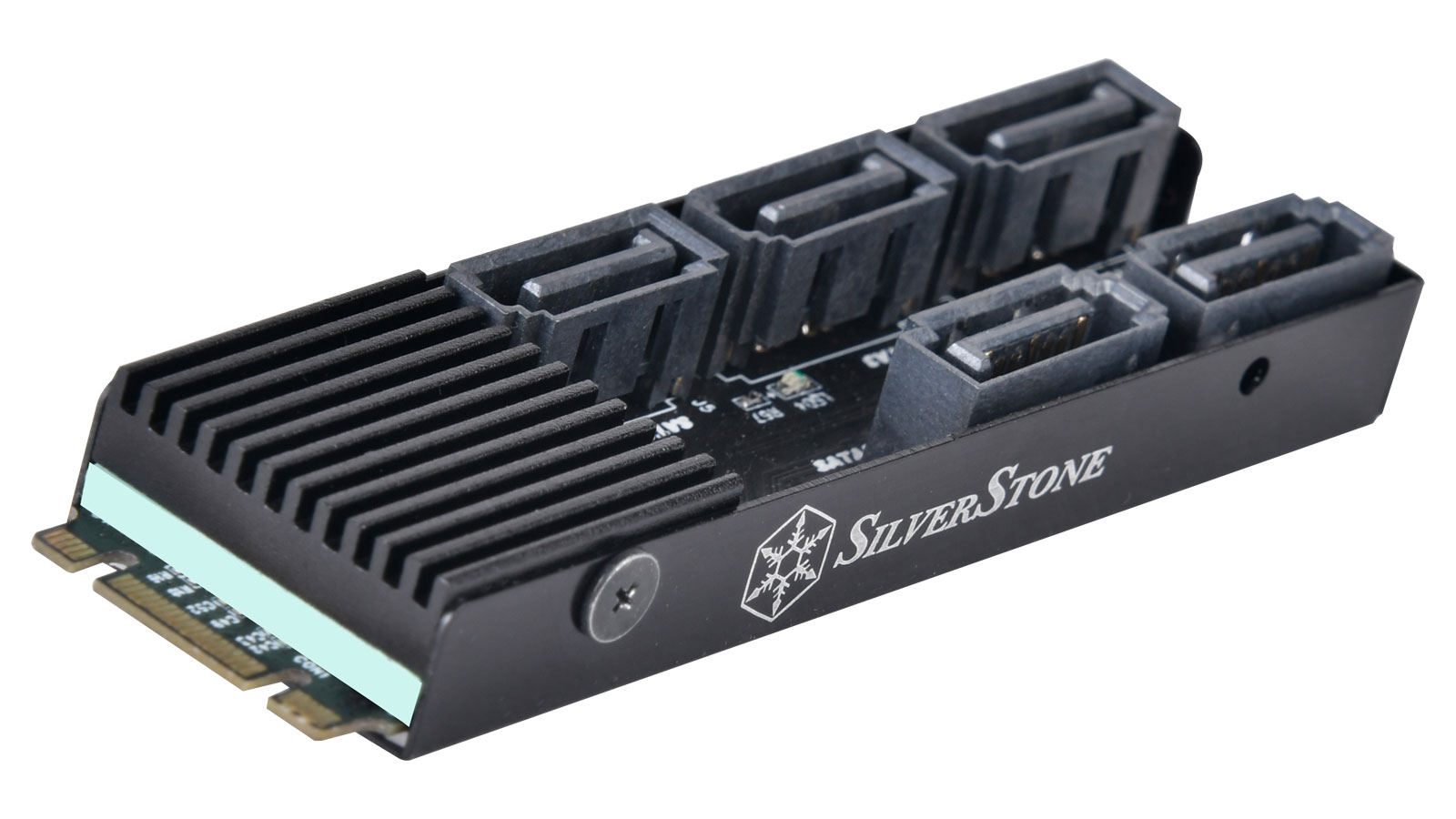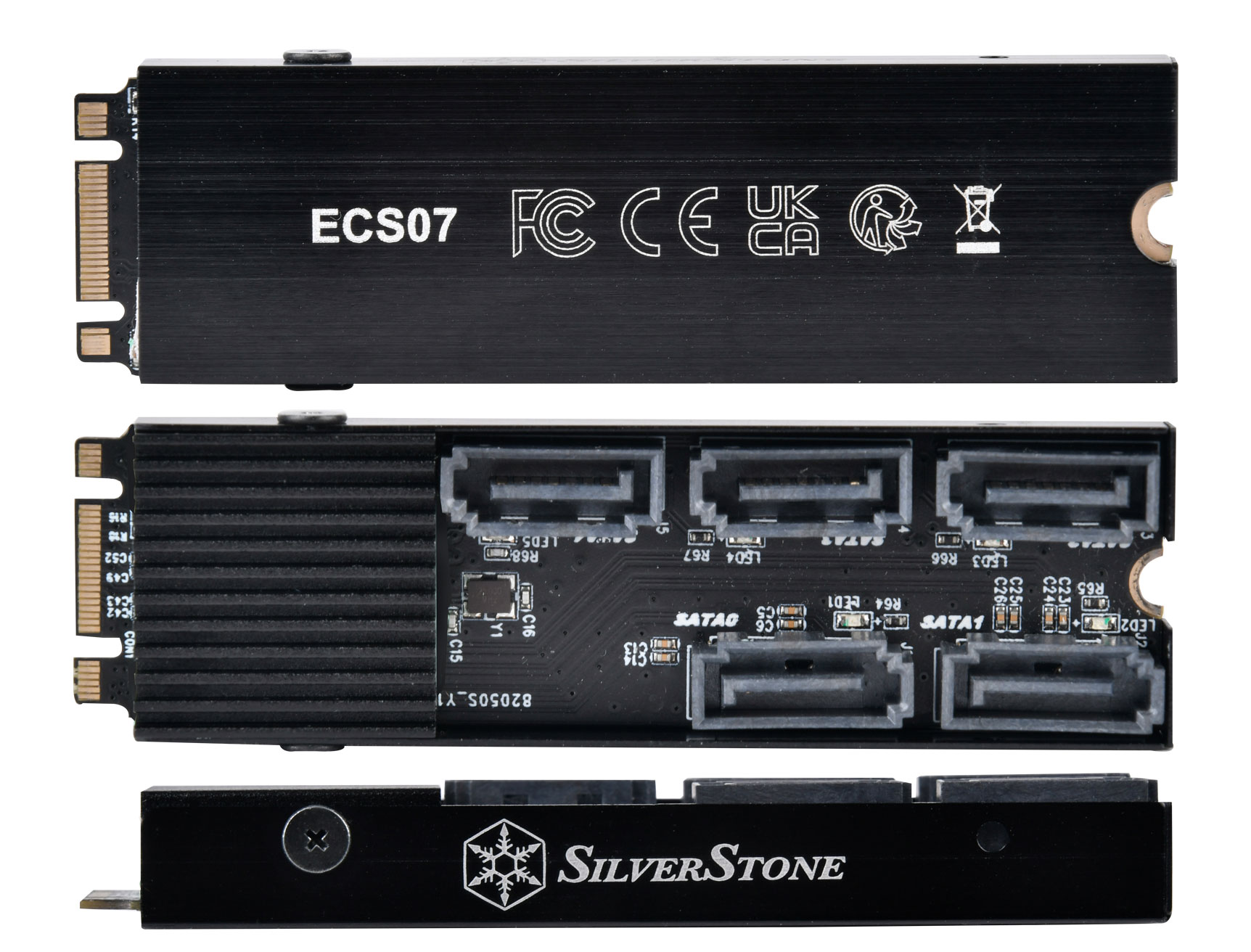Silverstone Turns One M.2 Slot Into Five SATA Ports
For the M.2 rich but SATA poor, or maybe a NAS
Silverstone has introduced a new product that will appeal to those who are M.2 slot rich but SATA port poor, or perhaps anyone who just wants to use more SATA drives. The new Silverstone ECS07 takes up one of your M.2 PCIe NVMe slots to provide five SATA 6Gbps ports, all wrapped up in a neat package with a JMicron controller kept cool under an alloy heatsink.
Silverstone has designed SATA expansion cards previously, typically using designs that plug into a PCIe slot, but this is its first model that relies on the increasingly ubiquitous M.2 port. Potential users will need an M.2 port with PCIe NVMe Gen 3 x2 interface. Doing the math, this port provides just about enough bandwidth to cope with five SATA 6Gbps ports.
The x2 PCIe connection tops out at a theoretical 15.76 Gbps, obviously a lot less than the five SATA ports. However, real-world throughput of SATA SSDs tends to be 550 MB/s at most, and that's only in sustained sequential accesses. Take out the 8b/10b encoding overhead and each SATA port would max out at around 4.4 Gbps, or a combined 22 Gbps. It's a bit odd that Silverstone didn't opt for the full x4 PCIe interface, which would have provided more than enough bandwidth even with a sixth SATA port. In real-world use, however, it's unlikely all five SATA ports will routinely end up fully loaded.
Silverstone says its aluminum alloy heatsink helps with heat dissipation, generated when the controller is working hard, to ensure stability. It seems such a controller wouldn't normally generate a lot of heat, but with the large SATA connectors it's not like the adapter would fit into cramped M.2 slots.
Folks with high-end motherboards bristling with SATA ports probably aren’t going to be interested in this adapter. Rather, it would fit in with someone building a compact NAS system, or a compact HTPC that could use a lot of local storage. Motherboards for such compact builds, often Mini ITX in form factor, don’t normally come with a lot of SATA ports but should have at least one fast M.2 PCIe NVMe slot.
The Silverstone ECS07 is pleasingly small, at 24.8mm (W) x 10.3mm (H) x 80.5mm (D) or 0.97" (W) x 0.41" (H) x 3.17" (D). However, one must remember that M.2 slots may be in places with little vertical clearance, like under a graphics card. While the device itself is only ~10mm tall, some angled cables might be useful to avoid clearance issues. Also purchasers will probably have to do some creative wiring to get power for the five extra SSDs / HDDs using these ports.
The ECS07 is plug and play, with no need for drivers or user-configuration. Storage device features such as sleep and power management are supported as well. With all the drives this little device enables, you might fancy implementing some RAID storage options for extra data security or performance, but the ECS07's controller doesn’t support RAID in hardware.
Silverstone has not yet announced pricing and availability.
Get Tom's Hardware's best news and in-depth reviews, straight to your inbox.

Mark Tyson is a news editor at Tom's Hardware. He enjoys covering the full breadth of PC tech; from business and semiconductor design to products approaching the edge of reason.
-
DRagor Interesting idea. So with PCIe x 16 to four M.2 adapter you could end up with additional 20 SATA ports per PCIe. Plus say three M.2 onboard for extra 10 (keep one for boot drive) and you end with 34-38 SATA ports (depending on what board starts with).Reply -
DRagor Reply
No idea. But I'm sure there is someone out there who just shouted "Eureca!".King_V said:(panic-tinged voice) . . why do you need 30+ SATA ports?!?
imagine connecting 30 HDDs, each making different sound while platters spin, and then making a app that spins them in such way to make it sound like orchestra playing your favorite song :ROFLMAO: -
bloodroses ReplyDRagor said:No idea. But I'm sure there is someone out there who just shouted "Eureca!".
imagine connecting 30 HDDs, each making different sound while platters spin, and then making a app that spins them in such way to make it sound like orchestra playing your favorite song :ROFLMAO:
Perfect for those running Unraid or other NAS based solutions -
jkflipflop98 ReplyDRagor said:No idea. But I'm sure there is someone out there who just shouted "Eureca!".
imagine connecting 30 HDDs, each making different sound while platters spin, and then making a app that spins them in such way to make it sound like orchestra playing your favorite song :ROFLMAO:
Like this? 3KS02q0BUnYView: https://www.youtube.com/watch?v=3KS02q0BUnY&ab_channel=Pawe%C5%82Zadro%C5%BCniak -
edzieba Take one of those mining motherboards with 18x PCIe x1 slots, add a corresponding pile of PCIe to m.2 adapters, and connect a frankly obscene 90 HDDs to a single system. And probably discover new and interesting SATA addressing bugs, I guess.Reply -
ezst036 This is actually a great solution to eliminate SATA ports altogether on some motherboards going forward. Many motherboards have two m.2 ports, well one of those m.2 can be for the "optional" SATA.Reply
I'd be happy to buy a new motherboard with zero SATA knowing this was in the box. -
fireaza There's already a similar product on Amazon, I picked one up when I upgraded my motherboard. They're pretty great, a lot more compact than a card and you can keep the cables lying flat against the motherboard for neatness. I also no longer have to deal with the SATA PCIe card blocking access to the rear ports on my hard drive bay, which is nice.Reply -
logainofhades ReplyKing_V said:(panic-tinged voice) . . why do you need 30+ SATA ports?!?
Lots of cat video storage.

